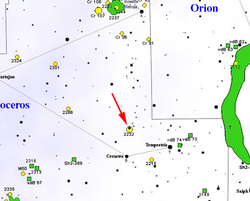Astronomy:NGC 2232
| NGC 2232 | |
|---|---|
 NGC 2232 (taken from Stellarium) | |
| Observation data (J2000 epoch) | |
| Constellation | Monoceros |
| Right ascension | 06h 27m 15s[1] |
| Declination | –04° 45′ 30″[1] |
| Distance | 1,060 ly (325 pc)[2] |
| Apparent magnitude (V) | 3.9[3] |
| Apparent dimensions (V) | 30′[3] |
| Physical characteristics | |
| Mass | < 100[4] M☉ |
| Radius | ~15 ly[4] |
| Estimated age | 30.9 Myr[2] |
| Other designations | Cr 93, C 0624-047[5] |
NGC 2232 is a bright open star cluster in the equatorial constellation of Monoceros, centered on the star 10 Monocerotis.[3] It is located in the Gould Belt close to the Orion Nebula cluster,[6] at a mean distance of 1,060 ly from the Sun.[2] The average radial velocity of the cluster members is 26.6±0.77 km/s.[7] This is one of the nearest open clusters to the Sun, which makes it a potentially useful target for studying young stars and their transition to the main sequence.[8]
The cluster has an angular radius of 36′ and a core angular radius of 7.2′. It is a sparse cluster with twenty high–probability members.[2] This is considered a super-solar cluster, with the components generally having a higher abundance of iron compared to the Sun. The mean metallicity is 0.22±0.09 or 0.32±0.08, depending on what assumptions are made.[7] At least four cluster members display an infrared excess at a wavelength of 8μm that is suggestive of warm dust, while the A-type star HD 45435 displays a strong excess at 24μm. The latter may indicate the star is in an early evolutionary state.[6] Only one member of the cluster appears to be chemically peculiar.[9]
References
- ↑ Jump up to: 1.0 1.1 Wu, Zhen-Yu et al. (November 2009), "The orbits of open clusters in the Galaxy", Monthly Notices of the Royal Astronomical Society 399 (4): 2146–2164, doi:10.1111/j.1365-2966.2009.15416.x, Bibcode: 2009MNRAS.399.2146W.
- ↑ Jump up to: 2.0 2.1 2.2 2.3 Kharchenko, N. V. et al. (2005), "Astrophysical parameters of Galactic open clusters", Astronomy and Astrophysics 438 (3): 1163–1173, doi:10.1051/0004-6361:20042523, Bibcode: 2005A&A...438.1163K.
- ↑ Jump up to: 3.0 3.1 3.2 Dunlop, Storm (2005). Atlas of the Night Sky. Collins. ISBN 978-0-00-717223-8. https://archive.org/details/collinsatlasofni0000dunl.
- ↑ Jump up to: 4.0 4.1 Finlay, Warren H. (2014), Concise Catalog of Deep-sky Objects, The Patrick Moore Practical Astronomy Series (2nd ed.), Springer Science & Business Media, p. 188, ISBN 978-3-319-03169-9.
- ↑ "NGC 2232". SIMBAD. Centre de données astronomiques de Strasbourg. http://simbad.u-strasbg.fr/simbad/sim-basic?Ident=NGC+2232.
- ↑ Jump up to: 6.0 6.1 Currie, Thayne et al. (November 2008), "A Spitzer Study of Debris Disks in the Young Nearby Cluster NGC 2232: Icy Planets Are Common around ~1.5-3 M☉ Stars", The Astrophysical Journal 688 (1): 597–615, doi:10.1086/591842, Bibcode: 2008ApJ...688..597C.
- ↑ Jump up to: 7.0 7.1 Monroe, TalaWanda R.; Pilachowski, Catherine A. (December 2010), "Metallicities of Young Open Clusters. I. NGC 7160 and NGC 2232", The Astronomical Journal 140 (6): 2109–2123, doi:10.1088/0004-6256/140/6/2109, Bibcode: 2010AJ....140.2109M.
- ↑ Orban, Chris; Patten, Brian (January 1, 2004), Late-Type Membership of the Open Cluster NGC 2232, Greenbelt, MD, United States: NASA Goddard Space Flight Center, https://ntrs.nasa.gov/search.jsp?R=20040082212, retrieved 2020-04-13.
- ↑ Jenkner, H.; Maitzen, H. M. (November 1987), "Photoelectric search for CP2-stars in open clusters. X. NGC 2232, NGC2343, CR 140, and TR 10.", Astronomy and Astrophysics, Supplemental Series 71: 255–261, Bibcode: 1987A&AS...71..255J.
External links
- Pang, Xiaoying; Li, Yuqian; Tang, Shih-Yun; Pasquato, Mario; Kouwenhoven, M. B. N. (2020). "Different Fates of Young Star Clusters after Gas Expulsion". The Astrophysical Journal 900 (1): L4. doi:10.3847/2041-8213/abad28. Bibcode: 2020ApJ...900L...4P.
 |


